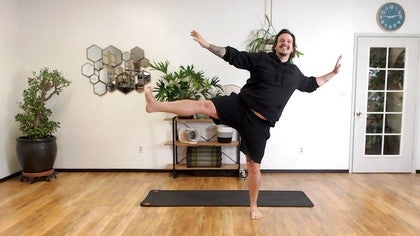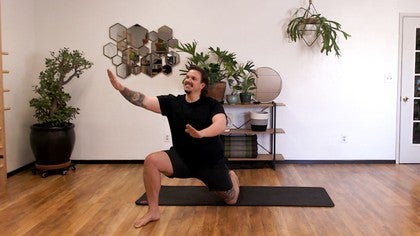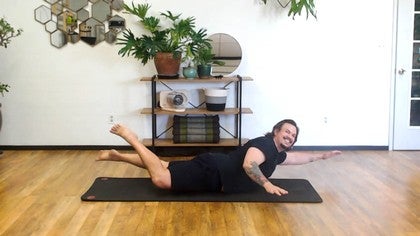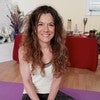Description
About This Video
Transcript
Read Full Transcript
Welcome, welcome everybody. I'm so excited for you to be joining me today on Pilates Anytime Live. I'm James Crader, and this is Curious Movement. This is, I think it's class four of this installment. So if this is your first time joining me, welcome.
And I urge you to go back and look at the previous few sessions because they help get you to where we are going today. Today, we're gonna have a leg day but we're gonna do it sort of my way. Let's go ahead and get started with some of our warm ups, some of our nervous system warm ups. We're gonna work our way there. So stay with me.
Go ahead and get comfortable whatever that means for you. Let's bring our hands together. Get started with some of these nervous system toning exercises. Once your hands are as warm as you would like them place your warm hands on the front of your throat and just be there with the warmth of your hands. The warm hands are doing all that they need to do.
You don't have to do anything other than just be with your warm hands. (inhales) (exhales deeply) Good. Now, if this feels good to you, stay here, do this thing. I'm gonna move on. I'm gonna have my right hand on the front of the left throat. Big, heavy hand draws towards midline as I twist my face towards the left, big heavy hand goes on the right throat, dragging it towards midline as I twist my face to the right.
Heavy hand, right hand to left throat. (exhales) Other side. (exhales) Just be there for a moment. Take in whatever it is you feel. Then I'm gonna go into some tapping.
I'm gonna put my hands on my collar bone, on my sternum, on my chest to just get a little tapping kind of waking up some of the body. (James exhales) I can turn that into some arm slaps all the way through down into some belly slaps. I can even go into my legs. They're gonna get plenty of attention today. So typically when we think leg day, we're thinking, oh, I'm gonna exercise my legs.
I want us today, maybe even going into your hands and doing some finger flicks, I want us today to start forming a more intimate relationship with the lower body. Finger flicks can become handshakes. So forming a more intimate, communicative, interconnected relationship with the lower body versus thinking why isn't it doing the thing that I want it to do? So we're gonna spend some time releasing and investigating and playing with the lower body. Good.
Now, maybe just slide the leg straight place your right hand behind you somewhere. Go ahead and take a look for right hand. You'll notice you twist. Take a deep inhale back here. (inhales deeply) (exhales deeply) Come back to center. Left hand goes behind you.
You take a look at it. Exhale. Let yourself be taken back to center. Right hand, one more time, each side. (James exhales deeply) And last one over here.
(James exhales deeply) Look down towards your feet and just let them wiggle. It's like they're just having their own temper tantrum, down there. Maybe that begins to wiggle the legs. Like you're just kind of, like we do with the hands in previous classes where we kind of shake them out for just shaking out the stress from the legs. This may be something you want to return to later.
We're gonna have a moment where we do a, what's called therapeutic tremor. Sounds big. Feels really good. But if you find that one is unaccessible to you, do this thing right here. Good. Okay.
I'm gonna invite you to sit. However you'd like to sit, but in a way where you can kind of feel your sit bones, those ischial tuberosities sitting down on something firm. (exhales) now, again, as I mentioned last week, I have a video on Pilates Anytime. It's somatic meditation video, we're gonna do sort of a very abbreviated version of that right here. If you want the full shebang, go to that video. I'm so happy with how it turned out.
It lives on Pilates Anytime. And it's amazing. So want you to just notice your sits bones and instead of going into judgy head going, oh, right side is high or left side or whatever it might be. That's just the reality of what is right now. That's my sits bones.
That's what they feel like. And that's okay. And I'm just gonna be here. Then I invite you to if you have your right and your left sit bone try to squeeze or pull them together. You're gonna notice there's sort of a pelvic floor contraction that goes on and then allow yield, rest, relax your way into wide sit bones.
I'm being very, very distinct and clear with my vocabulary here. There is a contraction, an efforting, a needing to do, pulling my sits bones together. There is simply a yielding, a relaxing, a dilating open to my sits bones being wide. You can't make your sits bones wide in this position. Instead, you can just not contract them.
So I'm asking you to relax your pelvic floor. I know, I said it, relax, relax the pelvic floor. Bring it all together and then just learn what it feels like to be dilated open and wide. I've said it before. I'll say it again.
I'm hoping my legacy here on Pilates Anytime and in the Pilates industry is wide sit bones. Not only is it healthier for your pelvis and for your hip joints, it's also healthier for your nervous system. When we get tense, stressed, scared, the pelvic floor contracts. Learning to allow your sits bones to be wide, (exhales) dilates open the entire nervous system. So just being wide, that is literally the practice for the rest of class.
How wide can I allow my sits bones to be? How relaxed can I let them be? Can I keep being aware of that? Maybe even mindful. And if you're like, what's the difference, check into last week's class.
What is going on down there and just be there with that. You can't get it wrong. It's just something to explore. Having said that let's move on. I'm gonna have an Elizabeth Larkam moment because she's a dear friend and I love her to death.
So we're gonna have sort of a, I'm a massage therapist by trade so I'm gonna give you a little thigh massage, a little foot massage, but it's gonna be very inspired by my good friend, Elizabeth Larkam. So pick a foot up and you're just going to have your hands and you're just gonna do a generic massage. This is like, you can't get it wrong. And I want you instead of thinking good foot, bad foot, or there's a problem, I want you to just appreciate the distinction between how the left foot feels versus the right foot during this experience. It's not, oh, this is something to fix later.
It's like, oh, look at that, this is what's going on over here. Then, and you can always just stay here doing this. You're gonna take the opposite hand. You're going to interlace fingers into toes giving a little foot to handshake going on. You're gonna use the entire shoulder, aha, the entire body to get this moving just making some circles and then reverse.
Think too often we ask our body to perform or to effort or to support us without enough nurturing without enough concern for like what's going on down there. What's going on with my feet. What's going on with my legs. So as you do this, I want you to think on my sits bones wide. What is the experience of this foot?
Now pause, do a little tug. What's the experience of this foot? How is this foot gonna be different than the other side? So that way, when it comes to later movements today, and in the future, you have a little bit more resourcing of what is going on in the low body. From there, you're going to take your pinky toe.
You're going to gently tug it away from your foot and twist it away from the other toes. So there's a gentle tug and twist away from the toes. Tug twist, tug twist, tug twist. Same for toe number four. Tug and twist it away from the other toes.
Same for toe number three, tug and twist. Toe number two is different tone. Toe number two, just gets a little tug. Toe number one, big toe, pulls and twists away from the toes. So it's going the opposite way.
If you get it wrong, no big deal, no big deal at all. Take a couple of toes. Just kind of do a little interlace like you're picking them up and moving them around one another, like maybe they're dancing. And then the others. And then the other.
(exhales) And again. Good. Now, place your thumbs on the bottom side of your foot and the fingers on top are going to pull the skin and the bones away from each other. Just kind of opening up the top of the foot and then in contrast, I'm opening up the bottom of the foot. Now, I'm taking my thumbs and moving them away.
Good. A little foot beat here. (exhales) And then just experience the difference between the two feet. Just from that very simple, very accessible, very short massage. What's the distinction.
And are your sits bones wide. Then other foot, starts off with the generic massage. You can't get it wrong. This side's gonna go a little quicker 'cause we know the drill. Fingers interlace with toes.
Whole body does this thing 'cause it's not just a foot warmup. (exhales) And then reverse. Good. Little tug. Grab your pinky toe, gently tug, twist it away.
It's like the toenail is moving away from the other toenails pull and twist, pull and twist, pull and twist. Toe number four, same thing. Pull, twist. Same with number three, pull, twist. Toe number two, gentle tug.
Big toe pull, twist away from the other toes. Pull, twist, pull, twist, pull, twist. Good. Thumbs go underneath, fingertips go on top. And you pull the top skin away from itself Getting a little fascial release there.
Then the bottom of the foot, pull away, pull away. So these next few weeks are gonna be all about self discovering. This week is lower body, then we have hands and head. And then we've got trunk of the body. I call them feel-moved weeks.
What I want you to think about, take the hand, pound but I want you to think about, during these sessions, is how little effort do I need to do in order to feel moved? What is going on? Where am I moving from? What is my relationship with these parts of the body? And then how is that gonna apply to my movement practice, to my Pilates practices and maybe just even practicing it on its own.
Good. And then just kind of be there for a moment. I now wanna jump on over to Lolita San Miguel and we're gonna have some foot exercises inspired by my time spent with her. Many people don't know that I did Lolita's full apprenticeship program and she is a dear lovely woman. So we're gonna have a moment for Lolita and do some foot exercises.
If this seated position does not work for you, build a fort, maybe roll up your mat, get a blanket, get a pillow, stick it underneath your bum here. Prop yourself up in a way that this sitting position is accessible to you. From their, wide sit bones, flex your feet flat. See if you can relax the toes, look at them. I think, do they look like two trees rising up or is one tree kind of a skew out to the side somewhere.
Feet rising up, then from there you're going to point without overly efforting through the toes. So it's a long foot, long, wide toes, flex your foot. I think of sliding my heel bones forward, point and flex. There's a point and there's a flex. Now, as you go through this rather than thinking, oh, this foot is good at this or this foot is bad, maybe one foot needs different attention than the other side.
Like for me, my right foot can be on autopilot. I don't ever need to monitor that. My left foot can get a little squirrely over here. So I'm just over here having an internal conversation with my left foot of, you're fine, you can do this we're good here. Then flex your feet flat, curl all of the toes over without sickling the foot or your legs kind of going skew.
Then flare the toes. Curl the toes, flare the toes. Curl toes, flare. I have had to work so hard to get the little pinky toe on the left to even begin to contemplate doing this exercise. So if you're like, that's not working for me.
It's fine. Practice, practice, practice if you want. Good. From there, let the toes pull back towards you. Point with the ball of the foot.
Take the toes over. Keep them over where they're active now, pulling back. This is when you're gonna start to see your feet go bananas. Pull the toes back, point with the ball of the foot. Let the toes come over.
(James groans) (James laughs) Go back. This makes me laugh every time I do this 'cause my left foot is just, it does its own thing over there. And I really have to go, why are you doing that to me foot? What do you need over there little guy? (exhales) Last one.
Good, now, from the ankles, make some circles. Good, and then reverse. Now, in contrast from the hip joints, make some circles. (exhales) I call this TV exercises. So like when you're watching TV at night you could be doing this.
This is so easy to integrate into your life and then reverse those circles. (exhales) Last two. Last one. Beautiful. From there, bring the soles of the feet together.
And we're just gonna rock side to side. Right sit bone to left sit bone. We're just gonna begin to kind of open up, investigate, explore hip joints a bit. So if you are new to mobility work, anticipate that you might run into some emotional discomfort. There shouldn't really be physical discomfort but emotional discomfort where you're like, why can't I do this?
What is going on? We're gonna have an exercise for that coming up. From there, little butterfly legs and you can pitch forward or you can come back. All of them affect the pelvis differently. Not a single one of them is right.
It's just to throw a technical word or phrase at you, it's cellular deformation. Positions in space I'm moving in, added to motion, affect the cellular structure or the way my body is differently. That's why it's saying there is a correct way to do an exercise, might not actually be correct. There's choices. There are different cells that can be moved.
Good. From there, you can keep doing that if that feels good, I'm gonna have my left leg to the front, my right leg to the side. It can be a 90, 90, 90 is more like this. It's kind of this leg out this leg in front. It's a little more advanced, I think.
I like to pitch my feet in just a bit. In fact, I'm gonna kind of go to the side here so that you can get a very clear idea of what's about to happen. I like to do a hard flex on my feet and monitor that my heels stay connected to the floor. Wide sit bones. How little work do you need to do to make this happen?
Arms go behind. And I'm just gonna flip my knees to the other side. Flip my knees to the other side. Notice that my feet are not leaving the floor. It's just my knees.
This is a pretty common mobility drill. And if you're new to it, give yourself some time. If this is like, yep, I do this quite frequently, James, try lifting your right arm off the floor. Keep your right arm off the floor and kind of explore this. (exhales) after you get bored with that switch arms.
Right arm goes down, left arm is up. This is my more testy Side. (exhales) Good. Now, pick a side to go to. Base that front leg.
Put your hands down. Slide your back legs straight, push down into the floor and then bring it back in. Press out, push down. Bring it back in. Out, push down, bring it back in.
Out, push down, bring it back in. Switch sides. We're over here. Hands go in front of you somewhere. Slide, push down and bring it back in hard flex on that foot to the best of your ability.
Check in with your experience. Can I soften, dilate open, relax, release. (exhales) One more. And bring it back in. Beautiful.
From there, I'm going to invite us to lie down. If this next experience is not for you, because we're gonna go into what's called TRE work, Tension and Trauma Release Exercise. We're gonna go into a therapeutic tremor for the pelvis in the legs. We hold so much tension and emotion down into the pelvis. This is a release exercise for that.
It's a very safe release. It's more safe emotionally than doing like stuff around the heart or around the neck and the head. But if for whatever reason, this is not for you, go back to these previous exercises. I'm gonna teach you a TRE exercise. So lying down, bring the soles of the feet together.
Push the soles of the feet together. Arms go down by your side. You are going to do a posterior pelvic tilt. Like you're gonna do a cat down below. Squeeze actively, purposefully squeezing the glutes.
Feet pushed together, butt cheeks squeeze, arms down to your sides and now do a half bridge. So it's not all the way up, sort of halfy. And we're gonna be here pushing the heels, the pinky toes, the big toes together, pushing your feet down, squeezing, squeezing, squeezing. Now dealing with stress, tension, anxiety is literally my job. So as I go through this, you're gonna watch someone who's familiar doing these, yours may not look like this yet because it might be new to you.
And that's fine. If this is interesting to you keep practicing and see what comes over time. We're gonna hold for five, four, three, two slowly relax. Keep your knees open wide sit bones and then bring your knees one inch closer together. If there's vibration, tremor, shakiness in your legs, that's exactly what you're looking for.
It's not there for me here. So I'm gonna go another inch closer together. It's not there yet for me. I'm gonna go to right about there. Now, I don't know if you can see this on your screen but my legs are in a tremor.
That is not a bad thing. That is your body releasing tension and trauma. I'm not experiencing anything emotionally right now. I'm just sort of like, wow, look at that, my legs are shaking. I'm used to this.
If someone, if this is like, ooh, I don't like that. The break on it is just slide the leg straight. It'll stop. I want this to go even more. So I'm gonna slowly bring my feet to the floor and let my legs quiver and shake.
Again, I do this practice so for me, this is like, yup, I can do this. I can allow this to happen. And I'm okay with it. This is literally shaking off tension and trauma from the pelvis and the legs. (exhales) Now for the sake of class, I'm gonna add in the braking system and stop.
If I was doing this on my own, I'd probably let this go as long as it wants to go. But for the sake of class, the braking system is simply slide one leg straight, slide the other leg straight, be there for a moment. Just fully release and relax. Now, you may want your legs straight, you may want your knees bent. I'm gonna have my knees bent as I lift one leg to the ceiling and I'm gonna point and I'm gonna flex, and point and flex and point and flex.
Then maybe some circles up there. Something like circles. Then instead, I'm gonna go well, can I wiggle my toes and circle and maybe even allow the knee to bend and the hip joint. I call this kaleidoscope leg. Meaning can you just surprise?
You know, when you're looking at a kaleidoscope and you get shocked, you get an awe inspired by the way that that light and filament move with each other. Can you surprise delight and shock yourself with how beautifully and gracefully and just inspiring your leg and foot can move. It's a moment of going, that's my leg like that. That is my foot. That is my leg.
That's pretty amazing. So cool. And then you can set it down, other leg, other side. (exhales) look at that, look at how that thing moves. And what I'm noticing is, oh, look at that the right knee, the right knee just moves a little more smart, a little more gracefully.
Now that I'm over here on the left it just needs a little more time in these simpler ranges of motion to just sort of get its footing underneath it. So I'm not gonna be shocked later if my left leg moves, functions, performs differently because it's just different. And that's fine. Good. Go ahead and set that foot down from there in your mind, visualize where your pubic bone is.
If you don't know, take a couple of fingers go all the way down to the front portion of your pelvis. And there's a bone that comes together and that's your pubic bone. Be there for a moment. I'm gonna put my fingertip on my pubic bone because that helps me. From there, did you know that embryologically your legs become a pair of legs?
They join into the body. There is union between the legs via the pubic bone. The pubic bone is the point in the body where the legs route out of embryologically. So that is the central access point for your legs. So I invite you to lift your left leg whatever that looks like and then set it back down, lift it again, (exhales) lift it again.
Then instead, imagine that that left leg lifts from the pubic bone. For me, that automatically, sets up, stabilizes, informs my pelvis, where it needs to be. I don't need to do a pelvic thing. And then a leg thing. It's like, oh, just picking my leg up from the pubic bone automatically does that for my body.
Again, I'm rehearsed at this. So if this feels new or different to you give it some time, explore it, play with it, see how it fits in to what, how you experience your body. Then jump over to the other leg, just do a few lifts. (exhales) (exhales deeply) Then a lifting from the pubic bone. (inhales) This is a level of awareness.
You can't do the leg lift from the pubic bone, right? I can't squeeze the pubic bone to lift the leg. It's, oh, I've got a pubic bone. And I'm going to just be aware that it is connected to that leg. Now, maybe this practice is so enjoyable, so important for you and maybe you should stay here.
I'm gonna turn over onto my side now. And we're gonna go into a side lying series here. You can certainly be up here. You can even be down here or you can be all the way here. It is up to you.
Slide both legs, relatively straight. Take an inventory of what's happening down at the feet. Are they pointed? Are they flexed? Are they forgotten about what's going on down there?
You choose. I'm gonna do a flexed flat. It's just what I like. I've got my pubic bone, this leg lifts because the pubic bone has asked it to lift and it goes up, and it goes up. Now, this is sort of a classic Pilates moment, right?
Like I can think of reaching that leg. I can think of pushing down, remember cardinal rule, push down to go up. But I've always wondered, like why do we stop here? Like what is right there that's stopping us. So I'm gonna go up there.
Then I'm gonna let leg rotate 'cause it's gotta rotate to lift and I'm gonna keep lifting it as if my pubic bone does that. Now, I can't keep it behind me or in alignment because it's gonna sort of disrupt everything. So I'm gonna learn over time that in order to lift it and keep going, that leg probably has to track in front of me somewhere (exhales) in order for the pubic bone to lift it. Because if I keep lifting it, I'm gonna sort of have to roll backwards. And then that feels like my hip joint lifting.
It's like, I can't imagine the pubic bone doing that work anymore. So for me, I go and I do the classic Pilates and then I let it kind of come in front of me and I can feel that working the back of that hip joint and back down one more. (inhales) (exhales) Good. Now, lift it up. We can do some circles here and some reverse circles, which is great.
However, I'm wondering, how does it change if instead of doing some random circles if you imagined your leg as a calligraphy pen and you had to write your first name as beautifully as you could write your first name on that wall, whatever that wall is. So I'm gonna point. And I'm gonna beautifully write my name to the best of my ability (exhales) on that wall. Good. And just think of all of the interesting ranges of motion you just put that leg through.
Let's go ahead and do the other side. You know, someone just literally chose circles, Joseph Pilates, and then whoever else came after him, right? Just said, we should just do circles and circles are great but so are other shapes. So this is me advocating for you to explore what other shapes can your body make. Now I can go up (exhales) and back down and up (exhales) and back down.
Up. (inhales) Now again, I can do circles or, and this is gonna be really interesting for my body how am I gonna write my name over here. (exhales) Ooh,?? such a different experience over on this side. From there, go ahead and lie on your back again. Come on mic pack, go ahead and lie on your back again. (exhales) From there, we're gonna do an exploration of a shoulder bridge.
So let's just play with bridge again. I put my hands down. I put my feet down. Is that really where I want them? For me, I always like a little bit of asymmetry 'cause it helps me feel symmetrical.
So I put my left foot out and my left arm out to the side a bit and lift from there. If I don't, it feels like I'm overly efforting through some muscle. So I'd rather just have my body locate itself, resource itself, do something that makes me feel organized and whole versus squeeze. As I go up sits bones are wide. As I go down, sits bones are wide.
I'm gonna now just let go of my hands and go well can the legs do that thing. As I go up, I'm gonna go up so much that my eyes begin to shift to look for the wall behind me, my chin lifts. And I use the back of the head and the shoulders to push up a little higher and then I come back down. So I can't necessarily keep my neck in alignment and do that. I want to recruit the full back line of muscle including the back of the neck.
I'm not saying top of the head. I'm not saying push only with your neck. I'm advocating that it is okay to gently push with some neck muscle and back down. (exhales) It needs work too. So we're gonna go up to your highest moment. If it feels good for you to put your hands underneath you, go ahead and do that.
I like just having my hands down. From there, I imagine the space in between my pelvis and the floor as if there is an invisible force helping me up and I wanna keep that pelvis relatively high. From there, I'm gonna liberate one of my limbs to lift and it's sort of kaleidoscope. From there, that leg can explore. It can go down.
It can go up. It can go out to the side. I'm going to even allow my pelvis to move but I'm going to stay lifted and up. Maybe that foot even wants to go underneath and back up. (exhales) From there, set that leg down. Come down, give yourself a moment (exhales) and just appreciate the difference.
Undoubtedly, your nervous system was aroused. That was a lot of work. So (exhales) calm sits bones. Prepare, 'cause we got a whole other side to do. I'm gonna come up. (exhales) I'm gonna honor my neck, my shoulders, liberate, lift, (exhales) kaleidoscope.
Look at that amazing leg. (exhales) (exhales deeply) (exhales deeply) Set it down. All the way down. (exhales) Give yourself a moment to settle in. (exhales) Maybe a little shimmy. Maybe you wanna go back to therapeutic tremors. Maybe you just wanna be here. (exhales deeply) when you're ready, go ahead and sit all the way up. From there, we are going to go into this low kneel.
Again, if this position is difficult for you, stick something between the back of the thighs and the calves. Now, I'm gonna pay attention to where my pubic bone is to where my sacrum is and they're gonna go down. My head stays in between the pubic bone and the sacrum. It doesn't get to go forward. It doesn't get to go backward.
It stays aligned. From there, I lift and I lower. I lift, and I lower. Monitoring that it's not I throw myself forward and I come up, that my head and my pelvis are aligned so that my legs have to figure that out a bit. (exhales) Now, come up, tug your toes, get all of your toes to the best of your ability.
Come back down. (exhales) Go back up. Go back down. Go back up. Go back down. Hold.
Shimmy yourself backwards. Get a little more toe stretch there. And we go up (exhales), and we go back down, and we go up, and we go back down. (exhales) One more. (exhales) Put your hands on the floor, holding there.
We're gonna play a game of twister. So I'm gonna say left foot touches left hand (exhales) and back, right foot touches right hand. Left foot, left hand. (exhales) right foot right hand, (exhales) left foot left hand, right foot right hand. (exhales) Now, you can always stay there doing that. I'm gonna take us up a level, but for some water. Now, things like elephant, things like pike, things like downward dog often become problematic for people because they can't figure out what their lower body is doing because we're just sort of taking on shapes.
So come back to your mat, tuck your toes. From there, in order to take on the shape of a pike, which is the starting position for the elephant or downward facing dog for all of the things, I want you to get acquainted with where your heels are, monitor that your heels are not wider than your big toes. Can my heels be as wide as my big toes and wide sit bones. From there, I'm going to begin to drop my heels behind me toward the floor (exhales) like that. And then back down again, I drop my heels behind me (exhales) and then back down.
That's step one. While you are doing that, imagine that your knees are driving forward. So my knees are trying to flex or push forward as my heels drop backwards. So there is a push, pull moment going on in the legs. Again, it's to be mindful of don't overly work the dough.
You're just gonna go heels, (exhales) knees. (inhales) (exhales) Wide sit bones, heels, knees. (exhales) One more. Now, you can go back to twister and do that. You can do this pike moment or you can follow me along and combine the two. (exhales) Left foot, left hand. (exhales) and back. Right, (exhales) and back, heels knees. (exhales) (exhales) One more. (exhales) And rest.
Point your feet, set back, rock. (exhales deeply) Just be there again. You might've gotten worked up a little bit. Totally, totally fine. (exhales deeply) However you get there, come up to standing.
Now, there are so many courses on standing posture or alignment in standing. I'm going to make it so simple for you. Take your feet about as wide as you believe your body to be. You can have them underneath your sit bones if that works for you. I like to go a little wider.
Put your fingertips on your pubic bone again, take yourself over to the right. Take yourself over to the left. Right. (exhales) And left. Notice what you notice. As my pubic bone travels to the right, does it make friends with, arrive on top of, is it in relationship with the big toe or the heel?
As I go to the left, do I land over the toe or over the heel? To the right, to the left? Can you veer more towards landing over the heel, over the heel, (exhales) over the heel. Not so far back that you go into like a falling reflex. It's simply over and over versus over and over.
See the subtle difference there? (exhales) Then is my head somewhere in between pubic bone and sacrum. We've already practiced that today. (exhales) Are my sits bones wide? And can I just be here for a moment appreciating that. Now, in order to go to a balancing moment, I go pubic bone finds right heel and I lift a leg and I put it back down.
I go over pubic bone finds left heel. For me again, so different. When I go to the right, it's like, yep, there it is, landed, safe, here we are. When I go to the left, it's like how do I move out of the way here to lift that? I've gotta be really mindful over here to go, I have five toes, a heel and a pubic bone and a head.
I've got to be embodied. I can't make it happen. No news flash abs, core strength is not balance. Knowing where you are in space is balance. Abs, that's a myth, myth.
We're just sort of exploring side to side. Then I can take one foot in front and I can go pubic bone, finds that heel, pubic bone finds that heel, pubic bone finds that heel. That heel. (exhales) I can just sort of have a moment of almost like you're waltzing with yourself as I go through this that's my experience. It's like a very pleasant floating waltz. And think about when you've watched someone walk elegantly, there's like a floating look. (exhales) You're just kind of playing with that.
Now, you can be there or you can challenge that, you can go pubic bone over heel, this leg starts to get a little kaleidoscopeish. Can this leg almost try to throw you off balance a bit (exhales) and then it can calm down. And I can waltz over to this side and this leg. I've gotta be really mindful over here. So maybe this leg isn't as feisty.
Maybe it has a little self-compassion there for that. (exhales) And I come back and I just do a little rock. From there, unprovoked, unshown, I want you to do a squat. Go ahead and do a squat. Stand back up, do another squat.
Stand back up, do another squat. Stand back up. I'm gonna go get my fancy prop. If you think squats are out of your repertoire, here's what you're gonna do. Standing up, I squat. (exhales) I stand up, I squat, I decelerate and I'm back up.
I squat. Squats are an entry into a rest position. I'd like for us to sort of see if we can enter into that. So my sits bones are wide. I like to do a wide legged squat because you can't get it wrong.
As I go down, my pubic bone is going to talk, be in relationship with my heels and I go down and I'm not gonna stop here, I'm gonna rest. And then I'm gonna come back up. Again, I'm gonna go down (exhales) and I'm gonna rest and back up. I don't have the world's prettiest squat and I'm so okay with it. I know people that can go here and just squat down.
Great. That's not my body. My body is here and down to this rest position. If your rest position requires a chair, do that. Maybe it's a box.
Maybe it's a cushion. Then let's have one leg come forward. Waltz to be in between and down, (exhales) up, waltz, (exhales) up, float, (exhales) up, float, (exhales) up, float, up, float, (exhales) up, float, up, float, up, shake it out. Be there. (exhales deeply) Where am I?
What am I noticing in my legs? What's the quality of the sits bones. What's the quality of this experience, so far? How do I feel about it? What's coming up for me.
Then, let's go into the most human movement there is. When they say do this, 'cause this is human movement, I'm like, well, the most humany movement is walking. So let's have a walking practice. Last week, we talked about how to embody your walk. So if you need a lesson in like, how should I be walking?
What should I be doing? Where should I be? Go to last week's session. For today, we're gonna use our mat as inspiration. So come inside of your mat, take a sidestep towards the opposite side.
How many times have you practiced walking to the side? And then back. Here in my studio, one of the first pieces of homework so many people get, I call these Pavlovian homeworks. pick a hallway in your house. Every time you walk down that hallway, walk down sideways.
You'll remember 20% of the time and that's more than what you're doing now. We don't move laterally enough in our world. So this is advocating for moving lateral. Then what is it like if you twist your head to one side (exhales) versus the other side? Can you relax, (exhales) dilate, open?
Where are your feet? Where's the pubic bone? What's it in relationship to? How are you? How do you know you're doing what you're doing is the best philosophical question I can give you.
How do you know you're standing up? How do you know you're walking? How do you know you're alive, right now? Then come up to your tip toes. Walking, walking, walking, walking, (exhales) twist, twist, (exhales) and down, lift all of your toes.
Keep out of your toes. Keep them off the floor. It's like hot lava. Walking, (exhales) and walking. If it feels good, do the head twist. (exhales) (exhales deeply) Step in front of your mat.
Turn to face your mat. Pick your left leg up. Maybe even from your pubic bone, reach your right arm. Go forward. Waltz forward.
Other side. Waltz forward. (exhales) Backwards. (exhales) You can speed it up. Or you can take your time with it. Then walk like a normal human being.
It's just take a little walk. Maybe even around your mat. (exhales deeply) Notice your pubic bone. Is it in conversation with your heels at all? Where is your head?
Are your sits bones wide? Now, try walking backwards around your mat. (exhales) What do you notice? Does an anxiousness come up for you? Do you allow movement in the body or do you restrict? How do the feet know they're hitting the floor?
What hits first? I was telling a friend the other day, I think I'm gonna make a whole workshop called Pilates philosophy with all these philosophical questions. How do you know you're laying on the floor? How do you know your moving? Good.
Come back to your center. Pick all your toes up. Lay all of them down. Pick all of your toes up. Lay all of them down.
Pick them up, lay them down. Roll your feet to the right. Roll your feet to the left. Roll your feet to the right. Roll your feet to the left.
Roll them to the right. Roll them to the left. Find your center, lift your heels. It can be a full tiptoe. It doesn't have to be.
Lift your heels. Lift your heels. Lift your heels one more time. Then lift your heels, roll your feet over to the right. Keep your toes off the floor, over to the left.
It's like an around the world for the feet. That's like you're tracing the outline of your feet and then reverse that. (exhales) Notice tension for me immediately since bones wanna go narrow. So I gotta be mindful of that. I'm okay. You're okay.
We're okay here. That's my internal voice all the time. We're okay. (exhales deeply) Find your center. Pick your feet up.
Stomp them. It's like I'm alive. I'm alive. I'm alive. I'm alive. I'm here. I'm here. I'm here. (exhales) Be there. Just notice whatever you notice.
And think to yourself, what from today, am I gonna take with me? What felt really new? What felt really valuable? What felt really hard? Maybe it's not the full routine.
Maybe there were a couple of tidbits in there. Maybe it's the pubic bone. Maybe you've never thought about that. Maybe it's a foot thing. Some things to consider.
Some things to play with. As always put your hands on your heart. Take a nice deep inhale. Tell yourself thank you for showing up today. You did a really great thing for yourself.
Take a look around your environment. We are influenced by the environments we are in. We are not separate. You could not have done today's practice without the world around you. Take a look at your community.
Anyone on screen with you? Anyone in the room with you? Dogs, cats, animals of all sorts included. We are interconnected and we rely on each other and we are influenced and influencing each other all the time. So take your positive, good stuff out into the world.
Take care of yourself so you can do that. And when you need help ask for it, the world and your legs are here to support you. So thank you guys so much for joining me. Again, this is Pilates Anytime Live, Curious Movement. I'm James Crader and I can't thank you enough for being here today.
Thanks.
Mindful Movement: Curious Movement
Comments
You need to be a subscriber to post a comment.
Please Log In or Create an Account to start your free trial.






















